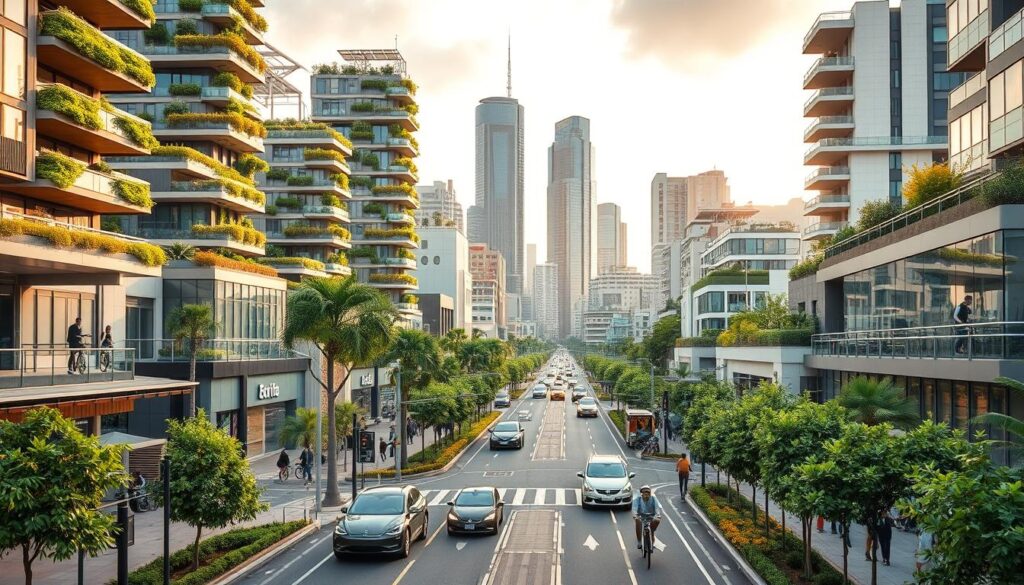Can urban planning strategies transform the way we live and commute? The answer lies in transit-oriented development (TOD), an innovative approach that focuses on creating vibrant, walkable neighborhoods around public transportation hubs.
TOD is defined as a dense, mixed-use development within a half-mile of transit stations, designed to increase transit ridership. By promoting sustainable urban design and mixed-use development, TOD can revitalize urban areas, enhance public transportation, and foster a sense of community.
As cities continue to grow, the importance of TOD in modern urban planning cannot be overstated. It’s a strategy that not only benefits the environment but also enhances the quality of life for residents.
Key Takeaways
- TOD promotes dense, mixed-use development around public transportation hubs.
- It enhances public transportation and fosters walkability.
- TOD is crucial for sustainable urban design.
- Mixed-use development is a key component of TOD.
- TOD can revitalize urban areas and promote community engagement.
What is Transit-Oriented Development?
At its core, Transit-Oriented Development is about creating vibrant, walkable communities centered around public transportation hubs. This approach to urban planning emphasizes the integration of public transportation options with dense, mixed-use development, fostering more livable and sustainable neighborhoods.
Definition and Overview
Transit-Oriented Development (TOD) is defined by its focus on compact, mixed-use development within a half-mile of transit stations. The U.S. Department of Transportation highlights that TOD is based on guiding principles such as mixed uses, equity, connectivity, and amenities. According to the Maryland legislature’s definition, TOD emphasizes dense, mixed-use development near transit stations, promoting a more efficient use of land and resources.
“The essence of TOD lies in its ability to connect people to places, providing a range of transportation options while fostering vibrant, inclusive communities,” as noted by urban planning experts. This development strategy is not just about transportation; it’s about creating livable communities that offer a high quality of life.
Key Principles of TOD
The success of TOD projects hinges on several key principles:
- Mixed-Use Development: Combining residential, commercial, and recreational spaces to create dynamic, diverse neighborhoods.
- Equity: Ensuring that TOD benefits all members of the community, regardless of income or background.
- Connectivity: Enhancing the connectivity between different modes of transportation and the surrounding community.
- Amenities: Providing a range of amenities, such as parks, shops, and services, to enhance the quality of life for residents.
By focusing on these principles, TOD can help create more sustainable, walkable communities that are centered around public transportation. As cities continue to grow, embracing TOD can be a key strategy for managing growth, reducing sprawl, and improving the quality of life for urban residents.
The Benefits of Transit-Oriented Development
The advantages of Transit-Oriented Development are multifaceted, impacting economic, environmental, and social aspects of urban living. By integrating transportation infrastructure with urban development, TOD can maximize the value created by transit investments, promote economic growth, and enhance social connectivity.
Economic Advantages
Transit-Oriented Development can significantly boost local economies through infrastructure investment and urban revitalization. By concentrating development around transit hubs, TOD initiatives can increase property values, attract businesses, and create jobs. For instance, a study on TOD projects found that they can lead to increased economic activity and higher tax revenues for local governments.
| Economic Indicator | TOD Impact | Non-TOD Impact |
|---|---|---|
| Property Values | Increase by 10-20% | Stable or Decrease |
| Job Creation | Higher density of jobs | Lower density of jobs |
| Local Business Revenue | Higher revenue due to increased foot traffic | Lower revenue |
Environmental Impact
TOD contributes to sustainable urban design by reducing the reliance on personal vehicles, thus decreasing carbon emissions and promoting more efficient use of land. By developing compact, walkable neighborhoods around transit stations, TOD can significantly reduce the environmental footprint of urban development.
For more information on why TOD matters, visit ITDP’s TOD Matters page.

Social Connectivity
TOD enhances social connectivity by creating vibrant, mixed-use communities where residents can live, work, and play in close proximity. This not only fosters a sense of community but also improves access to amenities and services, making urban living more appealing and convenient.
By promoting walkability and reducing the need for lengthy commutes, TOD can also improve the overall quality of life for urban residents. As cities continue to grow, adopting TOD principles can be a key strategy for creating more livable, sustainable urban environments.
Key Characteristics of Successful TOD Projects
Effective TOD projects typically incorporate a combination of elements that foster vibrant, sustainable communities. These elements work together to create neighborhoods that are not only economically thriving but also environmentally conscious and socially connected.
Mixed-Use Development
One of the defining features of successful TOD projects is mixed-use development. This approach involves combining residential, commercial, and recreational spaces within a single development or neighborhood. By doing so, it reduces the need for lengthy commutes, promotes walking and cycling, and creates a more dynamic, diverse community.
The benefits of mixed-use development are multifaceted. It enhances the local economy by providing a range of housing options and business opportunities, thereby attracting a diverse population. Moreover, it contributes to a more sustainable urban environment by reducing the reliance on personal vehicles and promoting more efficient use of land.
Walkability
Another crucial characteristic of successful TOD projects is walkability. Creating pedestrian-friendly environments encourages residents to walk rather than drive, reducing traffic congestion and improving air quality. Walkable neighborhoods also foster a sense of community by providing public spaces where people can gather and interact.
To achieve walkability, TOD projects often incorporate design elements such as wide sidewalks, pedestrian crossings, and accessible public transportation facilities. These features not only make walking safer and more enjoyable but also contribute to the overall aesthetic appeal of the neighborhood.
Integrated Transportation Options
Integrated transportation options are vital to the success of TOD projects. By providing a range of transportation modes, including public transit, walking, and cycling, these projects make it easier for residents to get around without relying on personal vehicles. This not only reduces traffic congestion and air pollution but also enhances the overall quality of life for residents.
| Characteristic | Benefits | Examples |
|---|---|---|
| Mixed-Use Development | Economic diversity, reduced commute times | Residential units above retail spaces |
| Walkability | Improved air quality, community interaction | Pedestrian-friendly infrastructure, public parks |
| Integrated Transportation | Reduced traffic, enhanced mobility | Public transit systems, bike-share programs |
In conclusion, successful TOD projects are characterized by a combination of mixed-use development, walkability, and integrated transportation options. By incorporating these elements, cities can create vibrant, sustainable neighborhoods that enhance the quality of life for residents while promoting economic and environmental sustainability.
Successful Examples of Transit-Oriented Development
Successful Transit-Oriented Development projects can be seen in various cities, offering valuable insights for urban planners. These examples demonstrate how integrating transportation systems with urban planning can lead to sustainable and vibrant communities.
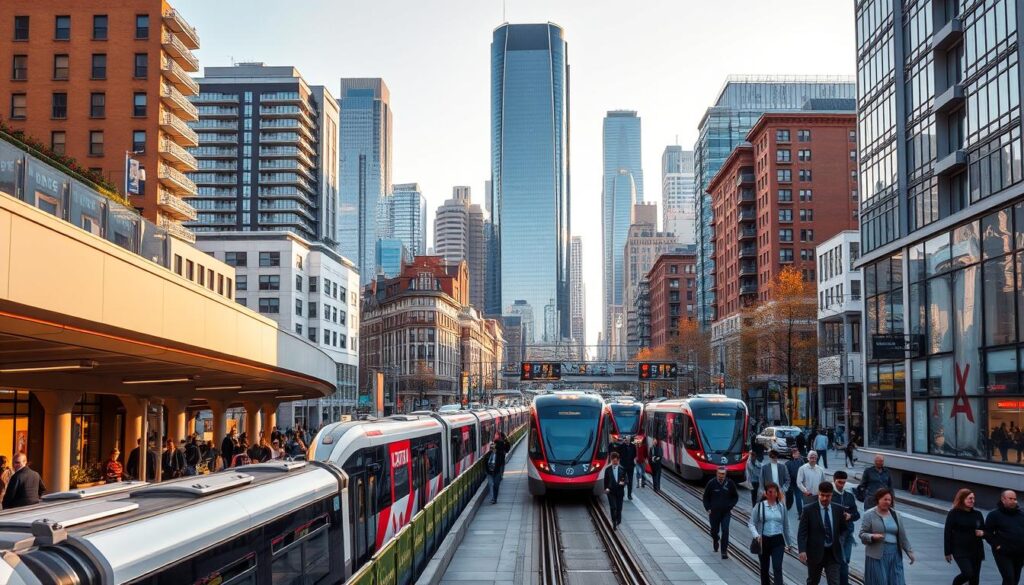
Case Study: Portland, Oregon
Portland, Oregon, is renowned for its effective implementation of Transit-Oriented Development. The city’s light rail system has been instrumental in shaping its urban landscape, promoting mixed-use developments around transit stations. This approach has not only enhanced the city’s walkability but also contributed to its environmental sustainability.
Case Study: Arlington, Virginia
Arlington, Virginia, is another exemplary model of Transit-Oriented Development. The county’s MetroRail system has been the backbone of its TOD strategy, with areas like Rosslyn and Courthouse being redeveloped into dense, mixed-use neighborhoods. Arlington’s approach has resulted in thriving urban centers that are well-connected and economically vibrant.
For more examples of successful Transit-Oriented Development, you can explore the top 10 case studies that highlight various urban revitalization strategies.
Lessons Learned from Other Cities
Other cities have also made significant strides in implementing Transit-Oriented Development. For instance, cities like Denver and Minneapolis have incorporated multi-modal transportation systems into their urban planning, enhancing connectivity and reducing reliance on personal vehicles.
The key lessons from these successful examples include the importance of community engagement, collaborative governance, and flexible zoning regulations. By adopting these strategies, cities can create more livable, sustainable environments that support economic growth and social equity.
Planning for Transit-Oriented Development
Planning for TOD involves a nuanced understanding of transportation planning, infrastructure investment, and sustainable urban design. Effective TOD planning requires a comprehensive approach that integrates various elements to create vibrant, accessible, and sustainable communities.
Stakeholder Engagement Strategies
Stakeholder engagement is a critical component of successful TOD planning. It involves identifying and engaging with various stakeholders, including local residents, businesses, and government agencies. By fostering a collaborative environment, TOD projects can better address community needs and concerns.
- Public meetings and hearings
- Surveys and feedback mechanisms
- Partnerships with local organizations
For more information on stakeholder engagement in TOD, visit Westchester County’s TOD planning page.
Zoning and Land Use Considerations
Zoning and land use policies play a crucial role in shaping TOD projects. By allowing for mixed-use development and denser, more walkable neighborhoods, zoning regulations can support the creation of vibrant transit hubs.
| Zoning Strategy | Description | Benefits |
|---|---|---|
| Mixed-use zoning | Combines residential, commercial, and recreational spaces | Encourages walkability, reduces commute times |
| Inclusionary zoning | Requires a percentage of units to be affordable | Promotes socioeconomic diversity, affordable housing |
Infrastructure Requirements
Infrastructure investment is essential for creating accessible and vibrant transit hubs. This includes not only transportation infrastructure but also public amenities and services.
Infrastructure components may include pedestrian-friendly pathways, bike-share systems, and public Wi-Fi networks. By investing in these elements, cities can enhance the overall transit experience and support the growth of TOD.
Challenges in Implementing TOD
The path to successful Transit-Oriented Development is often obstructed by various challenges that require careful planning and strategic solutions. Despite its benefits, TOD faces numerous hurdles that can impede its successful implementation.
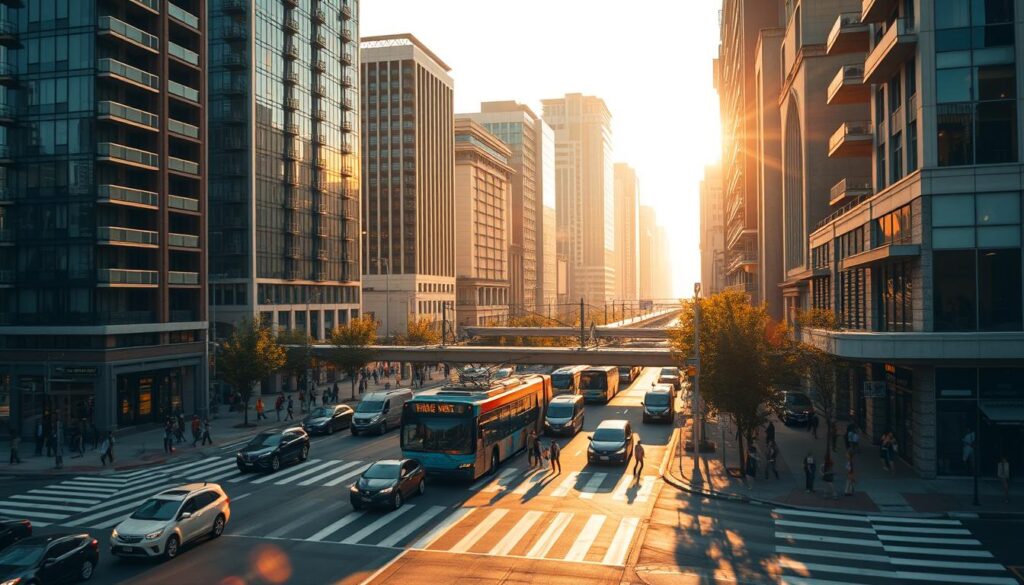
Funding and Investment Issues
One of the primary challenges in implementing TOD is securing sufficient funding and investment. Infrastructure investment is crucial for developing the necessary transit systems and supporting infrastructure. However, attracting investors and securing funds can be difficult due to the high upfront costs and long-term return on investment.
“The lack of financial resources can significantly hinder the progress of TOD projects,” as noted by urban planning experts. To overcome this, cities can explore innovative financing models and public-private partnerships to leverage funding and expertise.
Community Resistance
Community resistance is another significant challenge faced by TOD projects. Local residents may be concerned about the potential impacts of increased density and transit activity on their quality of life. Effective community engagement is essential to address these concerns and build support for TOD initiatives.
- Conducting public outreach and education campaigns
- Incorporating community feedback into project planning
- Highlighting the benefits of TOD, such as improved transit options and urban revitalization
Regulatory Hurdles
Regulatory hurdles can also pose significant challenges to TOD implementation. Zoning laws, land use regulations, and other policy frameworks can either support or hinder TOD efforts. Transit-Oriented Development requires a coordinated approach across different government agencies and levels of government.
“Regulatory frameworks that support mixed-use development and density around transit hubs are critical for successful TOD,” according to a report by the Urban Land Institute.
By streamlining regulatory processes and providing incentives for TOD, cities can create a more supportive environment for these projects.
The Role of Government in TOD
Government policies and incentives are crucial in fostering an environment conducive to Transit-Oriented Development (TOD). By providing the necessary regulatory framework and financial support, governments can encourage developers to invest in TOD projects, thereby promoting sustainable urban development.
Policy Support and Incentives
Governments can offer various incentives such as tax breaks, density bonuses, and streamlined permitting processes to attract developers to TOD projects. For instance, a study highlights how governments can collaborate with developers to create successful TOD initiatives.
The use of policy support mechanisms can significantly enhance the viability of TOD projects. This includes zoning regulations that encourage mixed-use development and pedestrian-friendly infrastructure.
Collaboration with Local Agencies
Effective TOD planning requires collaboration between government agencies, local authorities, and stakeholders. This collaborative approach ensures that TOD projects meet the needs of the local community while aligning with regional transportation planning objectives.
For example, local agencies can provide valuable insights into community needs, while government agencies can offer guidance on public transportation infrastructure and infrastructure investment opportunities.
| Agency | Role in TOD |
|---|---|
| Local Planning Department | Provides input on community needs and zoning regulations. |
| Transportation Authority | Oversees public transportation infrastructure and services. |
| Economic Development Agency | Offers incentives and support for developers. |
Funding Opportunities
Governments can explore various funding opportunities to support TOD projects, including grants, bonds, and public-private partnerships (PPPs). For more information on transportation network engineering, visit World Civil Society.
By leveraging these funding sources, governments can help bridge the financial gap often associated with TOD initiatives, making them more viable for developers and beneficial for the community.
In conclusion, the role of government in TOD is multifaceted, involving policy support, collaboration with local agencies, and the identification of funding opportunities. Through these efforts, governments can play a pivotal role in shaping the future of urban development.
Community Involvement in TOD Projects
The role of community involvement in shaping transit-oriented development (TOD) projects cannot be overstated. As cities continue to evolve, the need for inclusive, community-driven development strategies has become increasingly apparent.
Importance of Public Input
Public input is a critical component of successful TOD projects. By engaging with the community, developers can gain a deeper understanding of local needs and preferences, ensuring that the final product is both functional and beneficial to the community.
- Identify community needs and priorities
- Gather feedback on proposed development plans
- Foster a sense of community ownership
Effective public input mechanisms can include public meetings, surveys, and online engagement platforms. These tools help to ensure that all voices are heard and that the development reflects the community’s vision.
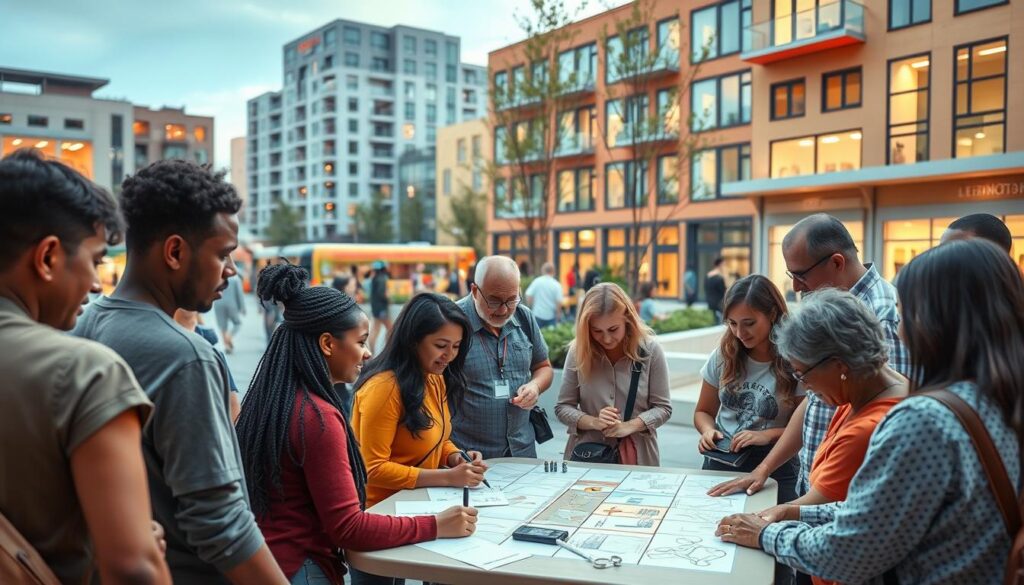
Building Local Partnerships
Building partnerships with local organizations and stakeholders is another vital aspect of community involvement in TOD projects. These partnerships can provide valuable insights, resources, and support, helping to drive the project forward.
- Collaborate with local businesses to enhance economic benefits
- Partner with community groups to address social needs
- Work with local government agencies to streamline regulatory processes
Successful partnerships are built on mutual trust and a shared vision for the community’s future. By working together, stakeholders can create TOD projects that are more resilient and beneficial to all parties involved.
Case Studies of Community-Driven Initiatives
Several cities have successfully implemented community-driven TOD initiatives, serving as models for other urban areas. These case studies demonstrate the positive impact of community involvement on TOD projects.
| City | TOD Project | Community Impact |
|---|---|---|
| Portland | Orenco Station | Enhanced local amenities and transportation options |
| Arlington | Ballston Quarter | Increased community engagement and local business growth |
These examples highlight the potential of community-driven TOD initiatives to transform urban landscapes and improve the quality of life for residents.
Future Trends in Transit-Oriented Development
Transit-Oriented Development is on the cusp of a revolution, with sustainability and technology leading the charge. As cities continue to grow and evolve, the need for efficient, sustainable, and well-connected transportation systems becomes increasingly important.
Technological Advancements
Technological advancements are playing a crucial role in shaping the future of TOD. Smart traffic management systems are being implemented to reduce congestion and improve travel times. Additionally, the rise of electric vehicles is changing the landscape of urban transportation, with many cities investing in EV charging infrastructure.
The integration of technology in TOD is not limited to transportation. Smart buildings and intelligent infrastructure are being designed to optimize energy use and reduce environmental impact.
Sustainability Practices
Sustainability is becoming a core principle of TOD. Developers are incorporating green building practices and sustainable urban design into their projects. This includes the use of renewable energy sources, green roofs, and energy-efficient buildings.
| Sustainability Practice | Benefit | Example |
|---|---|---|
| Green Roofs | Reduces urban heat island effect | Chicago City Hall |
| Renewable Energy | Decreases reliance on fossil fuels | Solar panels in TOD projects |
| Energy-Efficient Buildings | Lowers energy consumption | LEED-certified buildings |
Evolving Transportation Methods
The future of transportation is rapidly evolving, with new modes of transport emerging. Autonomous vehicles and mobility-as-a-service are set to revolutionize urban transportation, making it more efficient and accessible.
As transportation methods evolve, TOD projects are adapting to incorporate these new technologies. This includes designing infrastructure that supports multiple modes of transport and creating integrated transportation hubs.
The Impact of Public Transportation on TOD
Transit-Oriented Development (TOD) is intricately linked with the availability and efficiency of public transportation systems. Effective public transportation is crucial for the success of TOD, as it provides residents with convenient, affordable, and sustainable travel options.
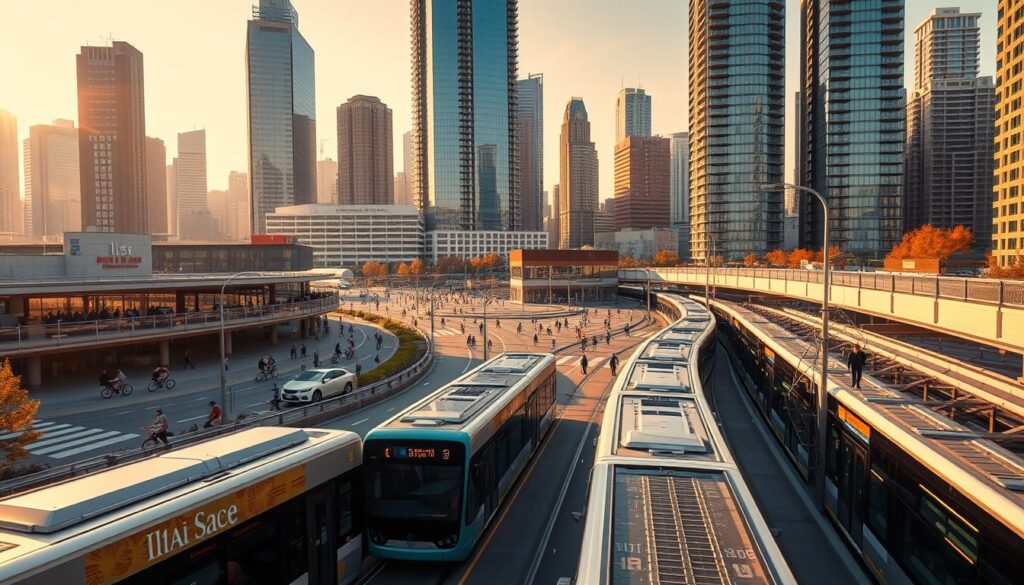
Public transportation encompasses a variety of transit systems, each offering unique benefits. Types of Public Transit Systems include buses, light rail, subways, and commuter trains. These systems play a vital role in supporting TOD by connecting residents to employment, education, and recreational opportunities.
Types of Public Transit Systems
The diversity in public transit systems allows cities to tailor their transportation infrastructure to meet specific needs. For instance, buses offer flexibility and can cover a wide area, while subways provide high-capacity transportation with minimal land use.
- Bus Rapid Transit (BRT) systems, which offer dedicated bus lanes and efficient boarding processes.
- Light Rail Transit (LRT) systems, providing a balance between capacity and environmental impact.
- Subway systems, known for their high capacity and speed.
- Commuter rail, connecting suburbs to city centers.
Financial Benefits of Transit Access
Access to public transportation has significant financial benefits for communities. It can lead to increased property values due to the convenience and accessibility it provides. Moreover, residents with access to reliable public transit can reduce their transportation costs by relying less on personal vehicles.
Studies have shown that properties near transit stations tend to appreciate in value, contributing to the local economy. Additionally, the reduced need for personal vehicles can lead to cost savings on fuel, maintenance, and parking.
Innovative Designs in TOD
The integration of innovative designs in TOD is enhancing the livability and sustainability of urban areas. By incorporating green building practices, creating urban green spaces, and utilizing public spaces creatively, cities can become more vibrant and environmentally friendly.
Green Building Practices
Green building practices are crucial in reducing the environmental impact of urban development. These practices include using sustainable materials, optimizing energy efficiency, and minimizing waste. For instance, buildings can be designed with green roofs, solar panels, and rainwater harvesting systems. A study on green building practices in TOD projects can be found in a case study that highlights the benefits and challenges of implementing such practices.
Benefits of Green Building Practices:
- Reduced energy consumption
- Lower operational costs
- Enhanced occupant health and productivity
Urban Green Spaces
Urban green spaces play a vital role in enhancing the quality of life for city residents. Parks, gardens, and green corridors not only provide recreational areas but also help in mitigating the urban heat island effect and improving air quality. Innovative designs can incorporate green spaces into TOD projects, making them more attractive and sustainable.
Creative Use of Public Spaces
Public spaces are essential in fostering community engagement and social interaction. Creative use of public spaces in TOD projects can include designing pedestrian-friendly streets, creating public art installations, and developing community centers. These elements can transform urban areas into vibrant and inclusive environments.
The following table illustrates examples of innovative designs in TOD projects:
| Design Element | Description | Benefits |
|---|---|---|
| Green Roofs | Roofs covered with vegetation | Reduces urban heat island effect, improves air quality |
| Public Art Installations | Artworks in public spaces | Fosters community engagement, enhances aesthetic appeal |
| Pedestrian-Friendly Streets | Streets designed for pedestrian safety and accessibility | Promotes walkability, enhances safety |
In conclusion, innovative designs in TOD are crucial for creating sustainable, livable, and vibrant urban environments. By incorporating green building practices, urban green spaces, and creative public spaces, cities can achieve urban revitalization and enhance the quality of life for their residents.
Measuring the Success of TOD Initiatives
As cities continue to adopt transit-oriented development, measuring its success becomes increasingly important. This involves evaluating various aspects of TOD projects to understand their overall impact on urban areas.
Key Performance Indicators
To assess the success of TOD initiatives, cities use key performance indicators (KPIs). These KPIs help in understanding the economic, social, and environmental impacts of such projects.
- Economic Growth: Increase in local business revenue and property values.
- Public Health: Reduction in pollution and improvement in air quality.
- Social Connectivity: Enhanced accessibility and community interaction.
| KPI | Description | Example Metric |
|---|---|---|
| Economic Growth | Increase in local economic activity | 10% increase in local business revenue |
| Public Health | Improvement in air quality | 20% reduction in particulate matter |
| Social Connectivity | Enhanced community interaction | 30% increase in public transport usage |
Community Feedback Mechanisms
Community feedback is crucial for understanding the social impact of TOD initiatives. Mechanisms such as surveys, public meetings, and social media engagement help in gathering insights from the community.
Effective community engagement not only fosters a sense of ownership among residents but also provides valuable data for project improvement.
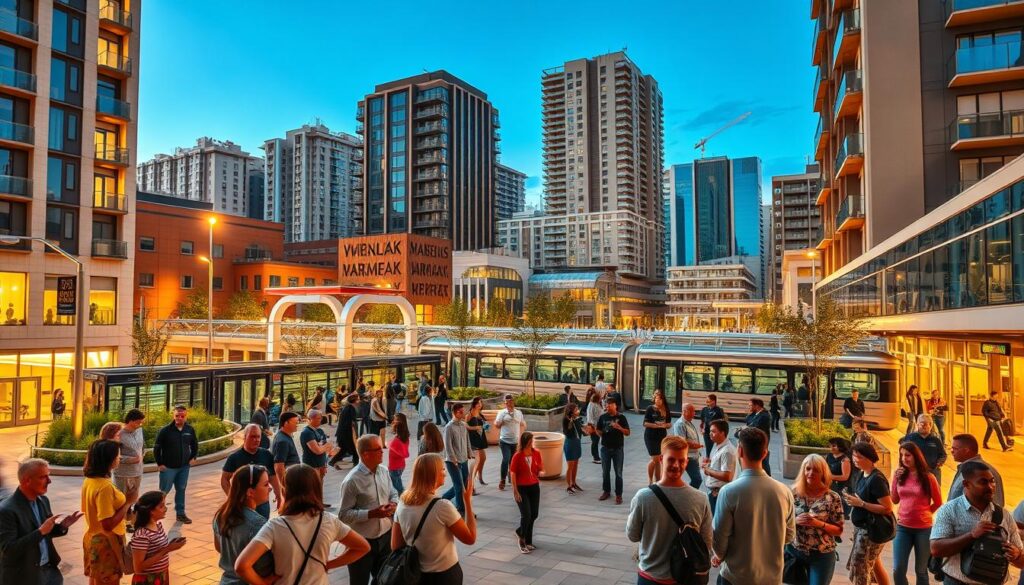
Long-term Impact Assessment
Long-term assessments are vital for understanding the sustained effects of TOD projects. This involves monitoring changes over several years to identify trends and areas for improvement.
By adopting a comprehensive approach to measuring success, cities can refine their TOD strategies, ensuring they achieve their urban revitalization goals while enhancing community engagement.
Transitioning Toward a Transit-Oriented Future
The shift toward transit-oriented development is a crucial step in creating sustainable urban environments. As cities continue to evolve, adopting strategies that promote transit-oriented development is essential for reducing congestion, improving air quality, and enhancing the quality of life for residents.
Strategies for Urban Areas
Urban areas can adopt several strategies to transition toward transit-oriented development. One key approach is to invest in infrastructure investment that supports public transportation, such as buses, trains, and bike-share systems. Cities can also implement zoning regulations that encourage mixed-use development around transit hubs, thereby reducing the need for personal vehicles.
For instance, a study on transit-oriented development highlights the importance of comprehensive planning in achieving successful TOD projects. This includes integrating transportation planning with land use policies to create vibrant, walkable communities.
| Strategy | Description | Benefits |
|---|---|---|
| Infrastructure Investment | Investing in public transportation systems | Reduced congestion, improved air quality |
| Zoning Regulations | Encouraging mixed-use development around transit hubs | Enhanced walkability, reduced reliance on personal vehicles |
| Community Engagement | Engaging local communities in the planning process | Increased public support, more effective planning |
Role of Developers
Developers play a critical role in implementing transit-oriented development projects. By investing in mixed-use developments near transit stations, developers can create vibrant, livable communities that attract residents and businesses alike. Moreover, developers can contribute to the success of TOD projects by incorporating sustainable building practices and designing spaces that promote social interaction.
A guide on cutting construction costs provides insights into how developers can optimize their investments in TOD projects, ensuring that they are both economically viable and environmentally sustainable.
Engaging Local Communities
Engaging local communities is a vital component of successful transit-oriented development. By involving residents and stakeholders in the planning process, cities can ensure that TOD projects meet the needs and expectations of the community. This can be achieved through public outreach initiatives and participatory planning processes, which help to build trust and foster a sense of ownership among community members.
Effective community engagement can lead to more successful TOD projects, as it ensures that the needs and concerns of local residents are addressed. This, in turn, can lead to increased public support and a smoother implementation process.
Conclusion: Embracing the Future of Urban Living
Transit-oriented development has emerged as a pivotal strategy in urban revitalization, offering a pathway to more sustainable, livable, and vibrant urban areas. By integrating residential, commercial, and recreational spaces around public transportation hubs, cities can significantly enhance the quality of life for their residents.
Benefits of Transit-Oriented Development
The benefits of TOD are multifaceted, including reduced traffic congestion, improved air quality, and increased economic activity. Sustainable urban design principles embedded in TOD projects promote walkability, mixed-use development, and efficient use of land, contributing to a more sustainable urban environment.
Call to Action
To fully leverage the potential of TOD, communities, policymakers, and developers must work together. This collaborative effort is crucial in planning and implementing TOD projects that are tailored to the specific needs of each community, ensuring that the benefits of urban revitalization are equitably distributed.
By embracing transit-oriented development, cities can create a more sustainable and livable future, enhancing the quality of life for residents and setting a new standard for urban living.
